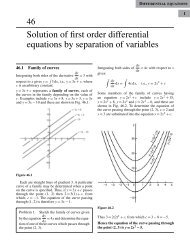vector
You also want an ePaper? Increase the reach of your titles
YUMPU automatically turns print PDFs into web optimized ePapers that Google loves.
Vectors 437<br />
And dx dy = projection of ds on the xy-plane = ds cos <br />
Putting the values of ds in R.H.S. of (2)<br />
F<br />
z<br />
F<br />
y<br />
<br />
1 1<br />
cos cos ds<br />
S<br />
<br />
=<br />
=<br />
R<br />
<br />
<br />
<br />
<br />
z<br />
cos y<br />
<br />
<br />
<br />
<br />
F1 cos F <br />
1 dx dy<br />
=<br />
R<br />
F1 F1<br />
dx dy<br />
cos cos <br />
z<br />
y<br />
cos <br />
F1 g<br />
F1<br />
<br />
<br />
dx dy<br />
R<br />
z y y<br />
<br />
F1 F1<br />
g <br />
= dx dy<br />
R<br />
<br />
y z y<br />
<br />
...(4)<br />
From (3) and (4), we get<br />
F c<br />
1 = F1 F1<br />
<br />
cos cos ds<br />
S<br />
<br />
z<br />
y<br />
<br />
...(5)<br />
Similarly, F c<br />
2 2 2<br />
= F<br />
F<br />
<br />
cos cos ds<br />
S<br />
<br />
x<br />
z<br />
<br />
<br />
<br />
...(6)<br />
and F c<br />
3 3 3<br />
= F<br />
F<br />
<br />
cos cos ds<br />
S<br />
<br />
y<br />
x<br />
<br />
...(7)<br />
On adding (5), (6) and (7), we get<br />
( F1 dx F2 dy F3<br />
dz)<br />
c<br />
=<br />
<br />
S<br />
F1 F1 F2 F2<br />
cos cos cos cos <br />
z y x z<br />
F3 F3<br />
<br />
cos cos ds Proved.<br />
y<br />
x<br />
<br />
5.39 ANOTHER METHOD OF PROVING STOKE’S THEOREM<br />
The circulation of <strong>vector</strong> F around a closed curve C is equal to the flux of<br />
the curve of the <strong>vector</strong> through the surface S bounded by the curve C.<br />
<br />
F<br />
d r<br />
<br />
c = curl Fnds curl FdS <br />
S S<br />
Proof : The projection of any curved surface over xy-plane can be treated as kernal of the<br />
surface integral over actual surface<br />
Now,<br />
S<br />
<br />
<br />
( F)<br />
kˆ<br />
dS<br />
= ( ) ( )<br />
<br />
= [( iˆ)( F ˆj) ( ˆj)( Fiˆ)]<br />
dx dy<br />
<br />
F i j dx dy<br />
[ kˆ iˆ<br />
ˆj]<br />
<br />
S<br />
<br />
<br />
F F dx dy<br />
<br />
= ( y) ( x)<br />
S<br />
S<br />
<br />
x<br />
y<br />
Fx<br />
dx Fy<br />
dy [By Green’s theorem]<br />
= [ ]<br />
=<br />
S<br />
[ ˆ ˆ ] ( ˆ ˆ<br />
iFx<br />
jFy<br />
idx j dy)<br />
S<br />
= F <br />
. dr<br />
<br />
c<br />
<br />
curl F ndS ˆ = . d r .<br />
S<br />
c F<br />
where, F = F iˆ F ˆj F kˆand<br />
dr dx iˆ dyj ˆ dz kˆ<br />
x y z<br />
<br />
<br />
Example 85. Evaluate by Strokes theorem ( yz dx zx dy xy dz)<br />
where C is the curve<br />
C<br />
x 2 + y 2 = 1, z = y 2 . (M.D.U., Dec 2009)<br />
Solution. Here we have<br />
yz dx zx dy xy dz<br />
= ( yziˆ zxj ˆ xykˆ<br />
).( idx ˆ ˆjdy kdz)










